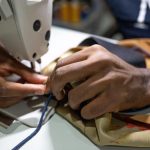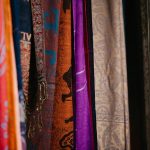Looking for the right fabric to wear underneath your leather armor? It’s crucial to choose wisely, considering factors like breathability, comfort, insulation, durability, and style.
You want a fabric that keeps you cool, moves with you, regulates temperature, withstands wear and tear, and enhances the overall look of your armor.
In this article, we’ll explore different fabric options that meet these criteria, ensuring you stay comfortable and protected during your epic adventures.
Table of Contents
The Importance of Choosing the Right Fabric
You should consider the importance of choosing the right fabric to wear underneath your leather armor.
There are several factors to consider when selecting the fabric, and one of the most important is its ability to effectively wick away moisture. Leather armor can trap heat and sweat, leading to discomfort and even skin irritations.
Synthetic fibers such as polyester or nylon are excellent choices for this purpose. These materials have moisture-wicking properties that help to keep your skin dry and cool. They quickly absorb moisture and transport it to the outer surface of the fabric where it can evaporate, leaving you feeling comfortable and fresh.
Additionally, synthetic fibers are known for their durability and strength, making them ideal for use in protective clothing like leather armor. They can withstand rigorous movements without tearing or losing their shape.
Factors to Consider When Selecting Fabric for Underneath Leather Armor
When selecting material to go beneath leather armor, it’s important to consider various factors.
One of the most important factors to consider is breathability. Breathable materials allow air to circulate, keeping you cool and comfortable during intense physical activity. Look for fabrics like mesh or lightweight cotton that allow air to flow freely.
Another factor to consider is moisture-wicking capability. Moisture-wicking fabrics draw sweat away from your body, keeping you dry and preventing chafing. Look for fabrics like polyester or nylon blends that have moisture-wicking properties.
Comfort is also a crucial factor to consider. Choose fabrics that feel soft against your skin and provide a comfortable fit. Avoid fabrics that are rough or irritating, as they can cause discomfort and distract you from focusing on your performance.
Durability is another important factor. Leather armor can be heavy and abrasive, so choose fabrics that are strong and can withstand the rigors of wear and tear. Look for materials that are sturdy and long-lasting, such as synthetic blends or reinforced cotton.
Breathability and Moisture-Wicking Fabrics
Breathable and moisture-wicking fabrics, such as mesh or polyester blends, are essential for staying cool and dry while wearing leather armor. When it comes to staying comfortable underneath your leather armor, it’s important to choose fabrics that can effectively manage moisture and allow air to circulate. Moisture wicking technology is a key feature to look for in these fabrics. This technology helps to pull sweat away from your skin and onto the surface of the fabric, where it can evaporate more easily.
Mesh fabrics are a popular choice for their excellent breathability. The open weave of mesh allows air to flow freely, keeping you cool during intense physical activity. Polyester blends are also a great option as they are lightweight and have moisture-wicking properties. These blends often incorporate synthetic fibers like nylon or spandex, which enhance the fabric’s ability to manage sweat and provide a comfortable fit.
When considering fabric composition, it’s important to choose materials that are both durable and comfortable. Leather armor can be heavy and restrictive, so selecting fabrics that are lightweight and flexible is crucial. Look for blends that have a high percentage of polyester or other synthetic materials, as these tend to be more breathable and moisture-wicking compared to natural fibers like cotton.
Comfort and Flexibility: Fabric Options for Enhanced Mobility
For enhanced mobility while wearing leather armor, consider opting for fabrics that offer comfort and flexibility. When it comes to fabric options for maximum comfort, there are a few choices that can provide the optimal flexibility needed for a comfortable wear.
One popular option is spandex, which is known for its stretchiness and ability to move with your body. Spandex is often blended with other fabrics to create a comfortable and flexible material that allows for unrestricted movement.
Another fabric choice for optimal flexibility is nylon. Nylon is a lightweight and durable fabric that offers excellent flexibility. It is often used in activewear due to its ability to stretch and bounce back to its original shape. This makes it a great choice for wearing underneath leather armor, as it allows for a wide range of motion without sacrificing comfort.
Additionally, cotton can also be a suitable option for increased comfort and flexibility. Cotton is a breathable fabric that allows for better airflow, keeping you cool and comfortable while wearing leather armor. It also has a natural stretch to it, allowing for ease of movement.
Insulation and Temperature Regulation: Fabrics for Various Climates
To regulate temperature and provide insulation in different climates, you should consider fabrics that offer suitable breathability and warmth. When choosing the right fabric for your clothing, it is important to consider its moisture-wicking properties and insulation effectiveness. Fabrics with good moisture-wicking properties are designed to draw moisture away from your body, keeping you dry and comfortable. On the other hand, fabrics with good insulation effectiveness help to trap heat and keep you warm in colder climates.
Here is a table that compares different fabrics commonly used for insulation and temperature regulation:
| Fabric | Moisture-Wicking Properties | Insulation Effectiveness |
|---|---|---|
| Cotton | Low | Low |
| Wool | High | High |
| Polyester | High | Medium |
Cotton, while comfortable, does not have good moisture-wicking properties and may not be suitable for intense physical activities or hot climates. Wool, on the other hand, is known for its excellent moisture-wicking properties and high insulation effectiveness, making it a great choice for colder climates. Polyester offers both good moisture-wicking properties and moderate insulation effectiveness, making it a versatile option for various climates.
When choosing fabrics for insulation and temperature regulation, it is essential to consider the specific climate and activity level to ensure optimal comfort and performance.
Durability and Longevity: Fabrics That Can Withstand Wear and Tear
When it comes to durability and longevity, there are key factors to consider for fabrics that can withstand wear and tear.
Strong synthetic fibers are a popular choice for their ability to withstand high levels of stress and strain.
Reinforced stitching techniques further enhance the durability of the fabric, ensuring that it can handle heavy use without unraveling.
Additionally, impact-resistant fabric options provide an extra layer of protection, making them ideal for applications where the fabric may come into contact with rough surfaces or objects.
Strong Synthetic Fibers
If you want a durable and protective fabric to wear under your leather armor, consider opting for strong synthetic fibers like polyester or nylon. These fabrics offer a number of benefits that make them ideal for this purpose:
-
Moisture wicking properties: Synthetic fibers are designed to draw moisture away from the body, keeping you dry and comfortable even during intense physical activity.
-
Comfort: Polyester and nylon are known for their softness and smooth texture, ensuring a comfortable fit against your skin. They also have a good amount of stretch, allowing for freedom of movement.
-
Flexibility: These synthetic fibers are highly flexible, meaning they can easily conform to the shape of your body, providing a snug and secure fit. This is crucial when wearing heavy leather armor, as it helps prevent chafing and discomfort.
Reinforced Stitching Techniques
For reinforced stitching techniques, you’ll want to use a strong thread that can withstand the stress of your leather armor. In recent years, there have been significant advancements in leather armor construction, leading to the development of various techniques to reinforce stitching and enhance durability. These techniques ensure that your armor remains intact during intense battles or rigorous training sessions. To give you a better understanding, here’s a table showcasing three common reinforced stitching techniques used in leather armor construction:
| Stitching Technique | Description |
|---|---|
| Lockstitch | Two threads interlock, creating a strong and secure stitch. |
| Whipstitch | Overcasting stitches along the edge, preventing fraying and providing reinforcement. |
| X-stitch | Cross-shaped stitches that distribute stress evenly, adding strength to the seam. |
Impact-Resistant Fabric Options
Now that you know all about reinforced stitching techniques, let’s move on to the next topic: impact-resistant fabric options.
When it comes to wearing fabric underneath your leather armor, you want to ensure that it provides maximum protection without compromising comfort. Here are some lightweight options for impact-resistant materials:
-
Kevlar: Known for its exceptional strength and durability, Kevlar is often used in body armor and motorcycle gear. It offers excellent resistance against cuts and abrasions.
-
Dyneema: This high-performance material is lightweight and incredibly strong. It is often used in sports and industrial applications due to its high impact resistance and tear strength.
-
Carbon Fiber: Although typically associated with armor plating, carbon fiber fabrics are also used in protective clothing. They are lightweight, yet provide excellent impact resistance.
Style and Aesthetics: Fabric Choices to Enhance Your Leather Armor Look
When it comes to enhancing the look of your leather armor, there are a few key factors to consider.
First, choosing a fabric that complements the color scheme of your armor can make a big difference in the overall aesthetic.
Additionally, paying attention to the texture and visual appeal of the fabric can add depth and interest to your outfit.
Complementing Color Schemes
Choosing the right fabric to wear underneath leather armor is important for complementing color schemes. When considering complementary color combinations, keep in mind that lighter fabrics can create a striking contrast against dark leather armor, while darker fabrics can enhance the overall richness of lighter armor.
To further enhance the visual appeal, consider the fabric texture options available. A smooth and sleek fabric can provide a polished and modern look when paired with leather armor, while a textured fabric such as linen or suede can add depth and interest to the ensemble.
Lastly, don’t forget to consider the practicality of the fabric. Opt for moisture-wicking and breathable materials that will keep you comfortable during intense battles.
Texture and Visual Appeal
To enhance the visual appeal of your ensemble, consider pairing leather armor with a fabric that has a textured surface. Not only will this combination add depth and interest to your look, but it will also provide a balance between texture and comfort.
When choosing the fabric, opt for materials like linen or cotton that have a slightly rough or nubby texture. These fabrics not only complement the ruggedness of leather armor but also provide a comfortable layer against your skin.
To ensure your fabric maintains its texture and comfort, it’s important to follow proper fabric maintenance and care. This includes gentle washing, avoiding harsh chemicals, and storing the fabric properly to prevent any damage or loss of texture.
Practicality and Breathability
The key to staying comfortable in your ensemble is finding a fabric that is breathable and practical. When it comes to choosing the right fabric to wear underneath your leather armor, consider the following:
-
Moisture wicking properties: Opt for fabrics that have moisture-wicking properties, such as polyester or nylon blends. These fabrics are designed to pull moisture away from your skin, keeping you dry and comfortable during intense physical activity.
-
Fabric breathability: Look for fabrics that allow air to circulate freely, such as cotton or linen. These natural fibers are known for their breathability, which helps to regulate body temperature and prevent overheating.
-
Durability: Leather armor can be heavy and abrasive, so choose fabrics that can withstand the rigors of constant movement and friction. Look for durable synthetic blends or reinforced fabrics that can withstand the wear and tear.
Conclusion
In conclusion, when it comes to choosing the right fabric to wear underneath leather armor, there are several factors to consider.
Breathability and moisture-wicking fabrics are important for keeping you cool and dry during intense physical activity.
Comfort and flexibility should also be taken into account, as these qualities will enhance your mobility during combat or training.
Additionally, insulation and temperature regulation fabrics are crucial for adapting to different climates.
Lastly, durability and longevity are key for withstanding wear and tear.
By carefully selecting the right fabric, you can enhance both the functionality and aesthetics of your leather armor.
- Does Polyamide Keep You Warm - July 1, 2025
- Does Polyamide Cause Cancer - July 1, 2025
- Does Polyamide Breathe - July 1, 2025






